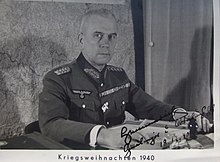ED50
| Geodesy |
|---|
 |
ED50 ("European Datum 1950", EPSG:4230
Background

Some of the important battles of World War II were fought on the borders of Germany, the Netherlands, Belgium and France, and the mapping of these countries had incompatible latitude and longitude positioning. During the war the German Military Survey (Reichsamt Kriegskarten und Vermessungswesen), under the command of Lieutenant General Gerlach Hemmerich, began a systematic mapping of the areas under the control of the German Military, a large part of Europe.[2] The allies were also concerned about the state of mapping in Europe, and in 1944 the US Army Map Service set up an intelligence team to collect mapping and surveying information from the Germans as the allied armies moved through Europe after the Normandy landings. The group, known as Houghteam after Major Floyd W. Hough, collected much material. Their greatest success was in April 1945. They found a large cache of material in Saalfeld, Thuringia, which proved to be the entire geodetic archives of the German Army. The shipment, 75 truckloads in all, was transferred to Bamberg, and then to Washington for evaluation.[3]
Shortly after this, the team captured the personnel of the Reichsamt für Landesaufnahme, the State Surveying Service, in Friedrichroda, also in Thuringia. This group had been working on the integration of the mapping of the occupied territories with that of Germany, under Professor Erwin Gigas, a geodesist with an international reputation. They were directed to continue this work, in Bamberg in the US zone of occupation, as part of the US-led effort to develop a single adjusted triangulation for Central Europe. This was completed in 1947.[4][5][6] The work was then extended to cover much of Western Europe which was completed in 1950, and became ED50.[4]
The European triangulation was originally classified military information. It was de-classifired in the 1960s, and became the basis for the definition of international boundaries in the North Sea.[7] It was, and still is, used in much of Western Europe apart from Great Britain, Ireland, Sweden and Switzerland, which have their own datums.
It used the
Many national coordinate systems of
The geodetic datum of ED50 was centred at the
Datum shift between ED50 and WGS 84
The longitude and latitude lines on the two datums are the same in the
This means that if the lines are further west, the longitude value of any given point becomes more easterly. Similarly, if the lines are south, the values become northerly. This is due to the fact that the International Ellipsoid is larger than the GRS 80/WGS 84 ellipsoid, so a given north-south distance will cover more latitude on the new ellipsoid, and a given east-west distance will cover more longitude.
The datum shift for the
References
- ^ "EPSG:4230". epsg.io. Retrieved 14 January 2022.
- ^ Kettle, Simon (5 February 2016). "The European Datum: A History (Part 1)". Esri Community. Retrieved 14 January 2022.
- ^ Kettle, Simon (29 February 2016). "The European Datum: A History (Part 2)". Esri Community. Retrieved 14 January 2022.
- ^ a b Kettle, Simon (21 March 2016). "The European Datum: A History (Part 3)". Esri Community. Retrieved 14 January 2022.
- ISSN 0002-8606.
- S2CID 119934421.
- ^ Whitmore, Guy Matthew (1997). Coordinate reference systems for high-precision geodesy (PDF) (PhD). Nottingham University. pp. 59–65.
See also
- The French datum RGF93
- The Great Britain datum OSGB36.
- For Ireland, the Irish Transverse Mercator.
- The Swedish datum RT90.
- The Switzerland datum CH1903.
